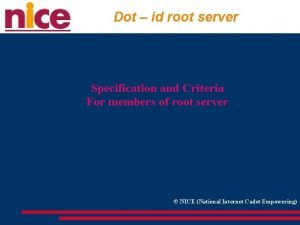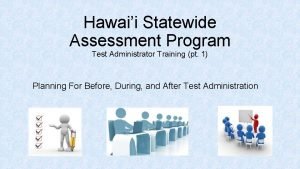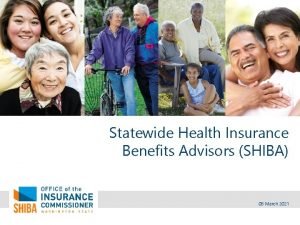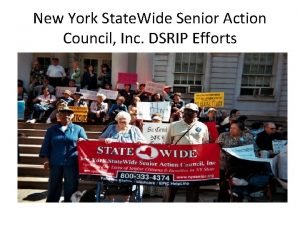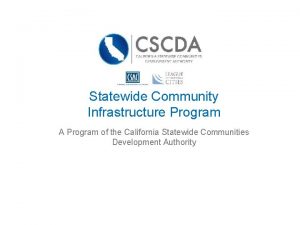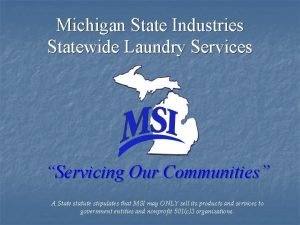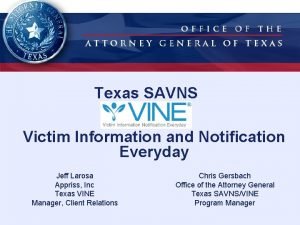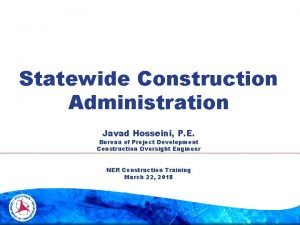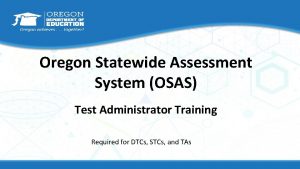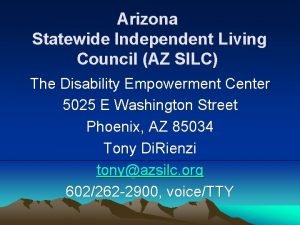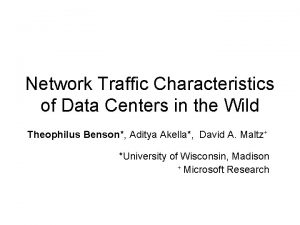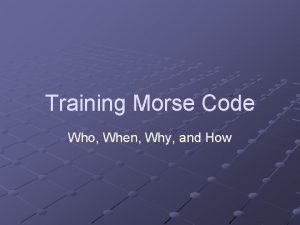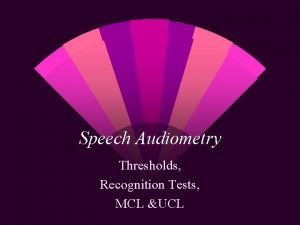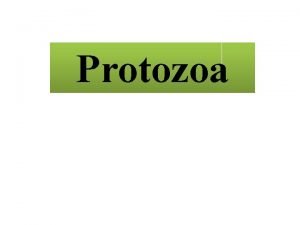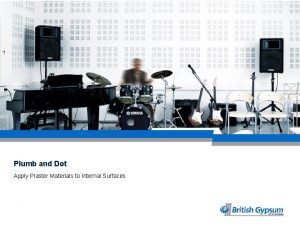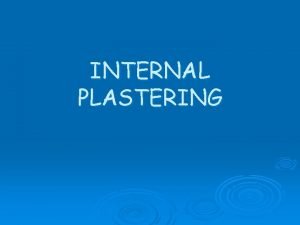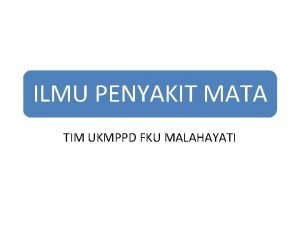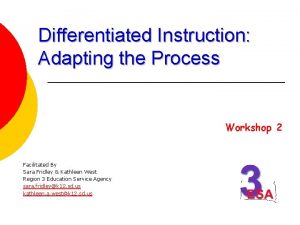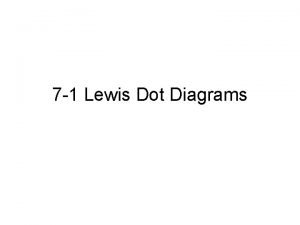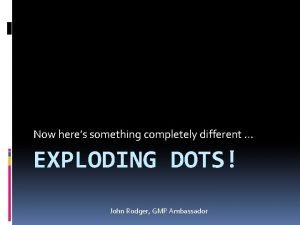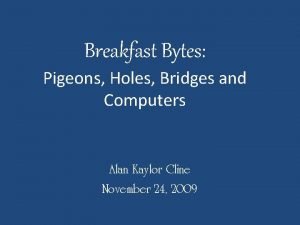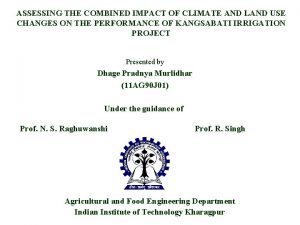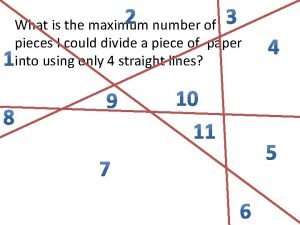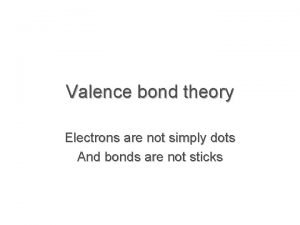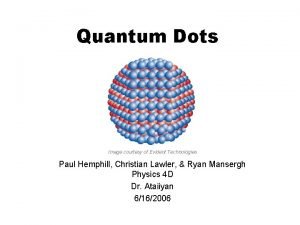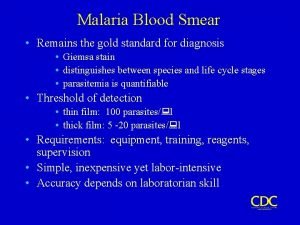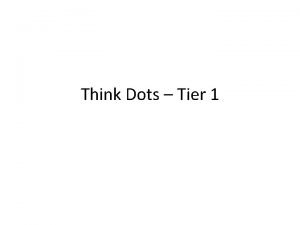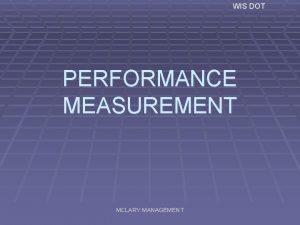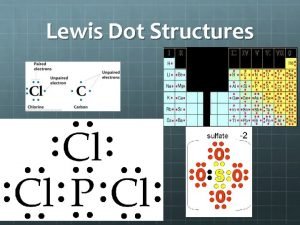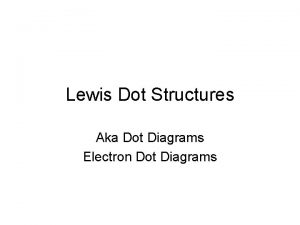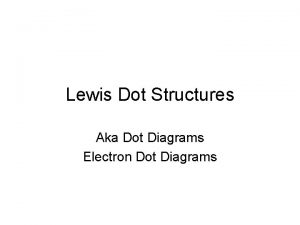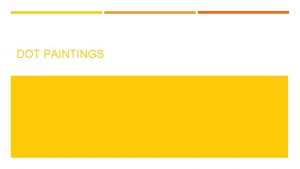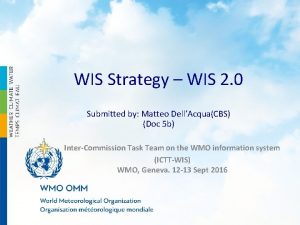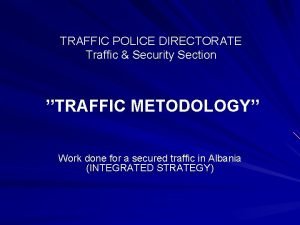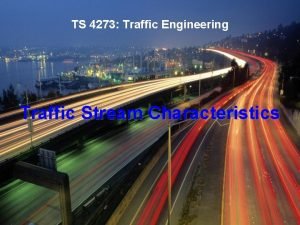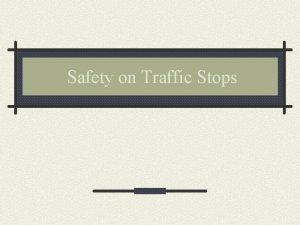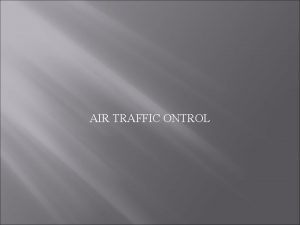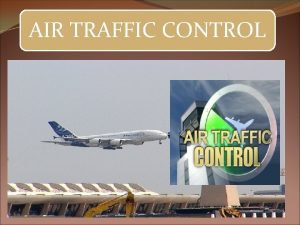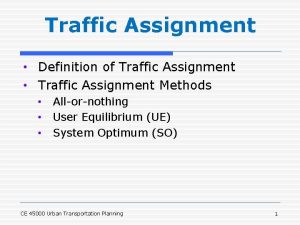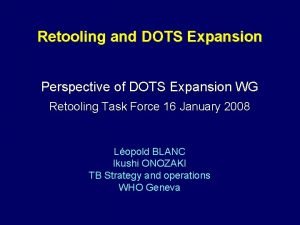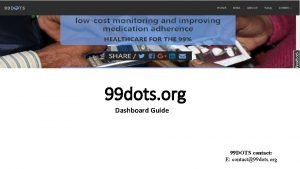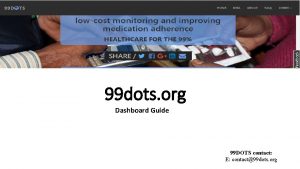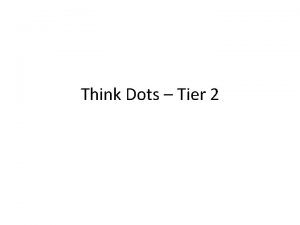Wis DOTs Statewide Traffic Operations Center Wis DOT










































- Slides: 42

Wis. DOT’s Statewide Traffic Operations Center

Wis. DOT STOC - Overview The mission of the STOC is to manage congestion and improve transportation safety, mobility, and efficiency on Wisconsin’s state highways • Operate traffic management and traveler information systems on WI highways • 24 hr / 7 day a week / 365 days a year • “Call Center” staffed by STOC Operators

STOC 2009 Org Chart

STOC - Monitor Traffic Conditions • System detectors are used to collect speed and volume data • Data collected is used to create travel times and populate system congestion map • Currently piloting probe technology: – Fleet-based solution

STOC - Monitor Traffic Conditions • Direct link to the Milwaukee County Sheriff’s Office computer-aided dispatch (CAD) – Incident details populate into STOC database and display on a congestion map • Direct link to the State Patrol CAD – Planned for May 2009 • Closed Circuit TV (CCTV) Camera images monitored by STOC Operators and used to locate traffic incidents – Milwaukee, Madison, GB, FDL, Wausau – Access to IL Tollway Video

STOC - Manage Traffic Congestion • Ramp Meters - Used to regulate traffic entering the freeway

STOC - Traveler Information • Provide travel times, congestion, incident and/or special event information via: – – – Dynamic Message Signs Portable Changeable Message Signs (Jam. Logic) Highway Advisory Radio Wis. DOT Web Site 511

511 - Overview • 511 provides real-time traveler information services on the state’s major highways, including the Interstate system • Utilizes an interactive voice recognition (IVR) phone system and Web site • Provides incident reports, lane closure information, winter road conditions, and travel times – Initially focusing on the Milwaukee area – Expanding to Madison and Wausau over the next year • Also provides transfers to transit services, State Patrol, County Sheriff Departments, airports, DMV, and other state’s 511 systems • Emergency alert feature allows all users (or only users in a targeted area) to hear a special message – i. e. AMBER alerts or emergency weather closures

Wis. DOT 24/7 Response Capabilities • If a highway dept or law enforcement agency needs to contact Wis. DOT, they can call: 1 -800 -375 -7302 • Operators working at the STOC answer the call • STOC makes notification for Wis. DOT response • Some examples include: signal knockdowns, bridge hits, flooding, and traffic incidents • STOC should be contacted for any incident anticipated to have at least one state highway lane/ramp blocked for greater than 30 minutes • NOT for general public use

Lane & Ramp Closure System An overview of the new features and a look at common closures.

LCS Objectives • Web-based system used to track closures and restrictions on Wisconsin state highways • Archive LCS data in the Wis. Trans. Portal system for future analysis and integration with other Wis. DOT / TOPS Lab traffic engineering applications and research • Facilitate data sharing with Wis. DOT applications that require lane closure data, such as 511 Traveler Information, Inconvenience Map production and Oversize/Overweight (OSOW) permitting • Improve the completeness, reliability, and timeliness of lane closure data on state highways • Integrate historical traffic flow data and capacity information to calculate available closure thresholds

Benefits • Coordinates activities to reduce back-ups and potential conflicts – Multiple activities can utilize the same closure – Avoid lane closures during a special event – Avoid conflicting lane closures on same highway • Eliminates duplications and inefficiencies by streamlining information into one system • Provides link to historical data that can be used to make informed decisions

System Use • What closures should be tracked? – All let projects (information formerly entered into Traffic Impediment Module) – Any planned maintenance or permit / utility work closure or restriction on: • IH & USH • Major state highways (Corridors 2030, 4 -lane +, detoured closures) – Emergency Closures (I. e. closures that are the result of an unexpected incident, such as a bridge hit or flooding, that result in the roadway being closed for an extended period of time) – All major special events • When should closures be entered? – 14 days - Project start or full roadway closure – 7 days - System ramp closure – 3 days - Lane and service ramp closure

User Roles • LCS User Roles – Administrator – Supervisor – Regional Traffic Engineer (RTE) - Regional Coordinator – Statewide Traffic Operations Center (STOC) – Project Manager (PM) – – – Permit Coordinator (PC) Maintenance Coordinator (MC) Project Leader (PL) Inspector (INSP) Requestor (REQ) Viewer (VIEWER) • System can be accessed via the Internet – therefore people outside of Wis. DOT can log on with a username and password

A note on entering • When entering closures, please remember: – Specific closure information must be used when entering data into the LCS. • A two month period indicating a roadway may be closed occasionally is not acceptable – For rolling closures, a specific date and time period should be entered • The location should be identified using the anticipated start and end point of the segment where the closure will take place – Full roadway closures must be entered directionally • One closure will be made for each direction

Acceptance Process Return / Reschedule Closure Request Forward Accept Complete

Acceptance Process Continued • When entering closures, please remember: – A Wis. DOT Regional Traffic Supervisor (RTS) must accept all freeway and expressway closures. • If a RTS is unavailable, Regional Operations Managers should make approval • Maintenance or project related staff should not be granted acceptance authorization – WISDOT PDS, Traffic, and Maintenance Supervisors should review closure information entered and accepted by staff with proper authorization on a weekly basis – It is important that closures be entered in accordance with the advanced notification guidelines previously outlined to allow adequate time for approval • Enhancements have been made to better facilitate the acceptance process – Acceptance authorization will only be allowed by the Traffic Supervisor for all freeway closures.

Data Accuracy & Completing Closures • It is critical that all closure information entered in the LCS be accurate – The closure information entered in the LCS is used to: • Provide traveler information through WI’s newly established 511 phone system and website (www. 511 wi. gov), where data accuracy will have a direct impact on the public’s perception of the value of the system • Issue OSOW permits, which has a direct impact on the movement of commerce through WI • Any closure entered for more than 14 days must be manually completed – This requires a user to enter the LCS and complete the closure – A closure will continue to be reported until checked complete – Closures less than 14 days will automatically discontinue reporting

Special Events • Special event information can be viewed within the LCS – Event information should be checked when scheduling closures to identify conflicts – The regional traffic section is responsible to enter special events that may impact traffic and are of concern when scheduling closures • This activity should be coordinated with the Regional Communication Managers • At a minimum, events should be entered into the LCS by the 15 th of every month. A report of all the events will be distributed to all PDS and Ops Supervisors

Special Events Continued • The Calendar Interface allows users to check for events prior to requesting a closure

Special Events Continued • Users can also check on Special Events in the Accept & Modify Interfaces before accepting or editing a closure

Web Address http: //transportal. cee. wisc. edu/closures

Request - General Section New Old • Disappearance of the duration drop down. • Disappearance of the External Comments • New naming scheme – Primary and Secondary contacts phone numbers will automatically populate

Request - Facilities Section New Old • The duration drop down is now in the facility section of a closure

Closure Duration • Daily/Nightly: closure occurs on a daily or nightly basis as specified by the starting and ending times per each day within the start date and end date range. • Continuous: closure is more than 24 hours but less than 2 weeks. • Long Term: closure more than 2 weeks.

Duration – Long Term • Long Term closures no longer have a timeframe associated with the dates of the closure.

Duration - Weekly • Weekly: reoccurs on a weekly basis as specified by the day of week dropdowns • New DOW location to make it easier to distinguish between the beginning and end days.

Accept Interface Old New • Can now search on a highway, not just a single direction • Project ID or Closure ID searches will override other parameters • Can search for multiple CID’s at a time – CID’s must be separated by comma or dash for a range and text field must be less than 35 characters

Modify Interface • Modify has been changed to “Edit” to avoid confusion with it’s function. • Closures longer than 14 days are changed to complete from the Modify Interface.

Searching Changes • Formatting changes have been made to the Accept, Modify, and Search interfaces • Overall speed of searches improved though all interfaces • Printable All makes it easier to print multiple closures • CSV (comma separated values) allows users to export data into an Excel file.

Reports Interface Old New • Many changes to the Reports Interface • Focus on active closures • Ability to lookup closures that only have OSOW restrictions • Recently modified searches • Again can narrow by Project ID or CID

Closure Walk Through • General screen filled in with all pertinent data – The more information entered, the easier it is to make contact with closure personnel

Closure Walk Through Type of facility (mainline, ramp, bridge or system interchange) Duration type (daily/nightly, weekly, continuous or long term) Closure is either a closure or restriction What’s closed (single lane, left shoulder, left lane, 2 left lanes etc. . ) If the closure location is not listed, find the closest point and give a direction and distance from Closure location OSOW Restrictions (place any restrictions that OSOW will use when creating routes / issuing permits) If a full closure is selected, a detour route will need to be entered Other useful information about the closure should be placed in the external facilities box If more than 1 facility will be needed, the add facility button will allow for multiple entries

Closure Walk Through • Here a single lane will be closed for one week, from 9 am to 2 pm • Be as precise as possible with the start & end time as-well-as with the begin and end locations

Closure Walk Through • A Weekly Duration is a closure that will start on Monday at 9 am and be picked up on Friday at 2 pm, for three weeks in April • This Continuous closure duration will be active from Friday the 3 rd at 9 pm and be picked up on Monday the 6 th at 6 am • This long-term closure will take place for the entire month of April When all the information is entered, submit the closure for review/acceptance

Closure Walk Through • If work will be done in the opposite direction, the Make. Like link will auto fill the General section of the closure – User will have to change the Hwy Direction

Closure Walk Through • The Edit button is where changes can be made to a live closure • Used when the new date/time are known • Rescheduled requires reacceptance • Used when date/time are unknown

Closure Walk Through • This long term closure will need to be “completed” when the work is finished • For closures with a single or multiple facilities, use Complete All button • A closure that has multiple facilities but only 1 is complete, use the facilityspecific complete button All closures lasting longer than 2 weeks need to be completed, regardless of the closure type (daily/nightly, weekly, continuous or long term)

Common Mistakes • Closures cannot be entered with a “vague” definition of when a lane closure may happen • Must be entered with specific dates & times – Unless the closure is truly long term

Common Mistakes • Closures cannot be entered with no begin and end time defined

Forgot Password • If a user lost his/her password, the user can follow the “Forgot Password” link to have their password reset

Contacts NE Pat O’Connor patrick. oconnor@dot. wi. gov (920) 492 -5641 NC Laurie Miller laurie. miller@dot. wi. gov (715) 421 -8394 NW Rick Tumaniec richard. tumaniec@dot. wi. gov (715) 833 -9815 SE Chris Quesnell chris. quesnell@dot. wi. gov (414) 225 -3727 SW Joe Schneider joseph. schneider@dot. wi. gov (608) 785 -9068 – For username/password questions, email: wislcs@topslab. wisc. edu – For questions about missing construction Project IDs, email: wislcs@topslab. wisc. edu – For additional questions about Wis. LCS reporting procedures, contact the Wis. DOT State Traffic Operations Center: Scott Kozlik Lead Operator Phone: (414) 227 -2161 E-mail: scott. kozlik@dot. wi. gov Doug Dembowski Supervisor (414) 227 -2149 douglas. dembowski@dot. wi. gov – Wis. DOT STOC 24 -hour phone number: (414) 227 -2142
 192 dot 168 dot 1 dot 1
192 dot 168 dot 1 dot 1 Connect the dots lewis dot symbols lesson 31
Connect the dots lewis dot symbols lesson 31 Incomina
Incomina All traffic solutions
All traffic solutions Sba testing hawaii
Sba testing hawaii Nova payee services
Nova payee services Statewide health insurance benefits advisors
Statewide health insurance benefits advisors New york statewide senior action council
New york statewide senior action council Statewide community infrastructure program
Statewide community infrastructure program Michigan state industries
Michigan state industries Vinelink texas statewide
Vinelink texas statewide Statewide construction and development
Statewide construction and development Statewide benefits
Statewide benefits Oregon test portal
Oregon test portal Vinelink texas statewide
Vinelink texas statewide Arizona statewide independent living council
Arizona statewide independent living council 1-5 solving equations and inequalities by graphing
1-5 solving equations and inequalities by graphing Java vs net
Java vs net Understanding data center traffic characteristics
Understanding data center traffic characteristics Farnsworth morse
Farnsworth morse Count the dots audiogram
Count the dots audiogram Dot
Dot Which artist utilized benday dots in his artwork
Which artist utilized benday dots in his artwork Dot wall
Dot wall Schüffner's dots vs maurer's
Schüffner's dots vs maurer's High suction backgrounds plastering
High suction backgrounds plastering Trantas dots
Trantas dots Tbnow
Tbnow Think dots differentiated instruction
Think dots differentiated instruction Think dots differentiated instruction
Think dots differentiated instruction Ocl2 lewis structure
Ocl2 lewis structure Darko hunter
Darko hunter History of quantum dots
History of quantum dots Dippin' dots precio
Dippin' dots precio Exploding dots.org
Exploding dots.org Connect the dots without crossing lines
Connect the dots without crossing lines Clear the blue dots
Clear the blue dots What is the maximum number of pieces
What is the maximum number of pieces Simply dots
Simply dots Evident technologies
Evident technologies Pop art benday dots
Pop art benday dots Malaria parasite in thick film
Malaria parasite in thick film Thinkdots
Thinkdots
